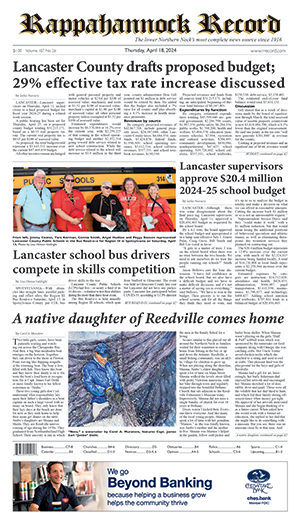KILMARNOCK—Bon Secours Rappahannock General Hospital (RGH) is here to stay, according to Bon Secours East chief executive officer Mark Gordon.
“It is a full-fledged hospital, a full-functioning hospital that is not going to close,” Gordon told some 300 citizens at a community meeting that included hospital employees and residents dependent on the hospital’s services.
The meeting took place June 6 at the Lancaster Middle School. After two-and-a-half hours, most citizens were left with more questions than answers.
“There is absolutely no question in my mind that we are getting to having the right conversations,” said Gordon in his opening statement. “In order for us to succeed, we have to collaborate.”
His statements were met with skepticism and distrust after Bon Secours (BS) dropped the bombshell last month that they were closing down RGH’s Intensive Care Unit (ICU) and stopping all surgeries after 3 p.m.—without any prior communication with employees or the community.
RGH chief of staff William Stallings, M.D., acknowledged the distrust and anxiety of hospital employees. He explained that BS is systematically investing in the hospital, both in technology and new services.
“Shrinking is not the right way to look at it,” he said of the cuts. “Changes have been going on for some time. We have a similar goal—how to best provide health care services for the community.”
Dr. Stallings said health care has changed dramatically over the past two decades.
“We have only occasional ICU patients, whereas MCV Hospital has the specialists who see multiple ICU patients every day,” he said.
He indicated RGH had only 69 after-hours and weekend surgeries last year which did not justify continuing that service. Also, he noted surgery has become sub-specialized over the last 10 years, making it best for patients to be cared for in larger facilities that had the advantages of specialized physicians and equipment.
The future of RGH is to provide care through hospitalists and nurse practitioners. A “progressive care unit” will be used to stabilize patients waiting for transport to larger metropolitan hospitals, he said.
“We’re putting resources into what’s best for the community,” he added.
Hospital financials
Gordon disputed RGH’s profitability and the Thomas Jefferson Institute’s report showing nearly $2.2 million in profits for 2016 as posted on the Virginia Health Information website last December.
According to Gordon, the hospital had losses of $500,000 in 2013, and $5.2 million in 2014, prior to BS’s take over.
BS staff distributed a fact sheet that claimed a $12 million loss in the following eight months, however, Gordon reported a loss of $800,000 for 2015 and another $1.2 million loss in 2016.
BS has made significant investments in “…behind-the-scenes services, foundational things,” said Gordon. “We’ve made the right investments in the foundation years, such as electronic records.”
He claimed substantial investments in a sleep lab, medical equipment, same-day mammography, electronic records systems and an emergency generator and chiller that resulted in delays in “bricks and mortar” investments.
For example, Gordon stalled plans to rehabilitate the emergency room in order to make the foundational changes. “It was not in the right sequence. We will get around to it,” he promised.
Disputed facts
He addressed BS’s fact sheet about what he called “the transition,” denying that it is headed toward a short term hospital. The proposed loss in services would not result in layoffs or reduced hours for employees, Gordon insisted.
Cee Cee Seldon said that was not true because she is already dealing with fewer hours. “How do we get 40 hours when you only do two surgeries a day? If you finish your work at 10 o’clock, how do you get your hours?” she asked. Between a shortage of surgeons and vacationing doctors, she doesn’t meet a 40-hour work week. “I would like a guarantee that I will get all my hours,” she said.
“Can I give you assurances? No,” said Gordon.
“But that’s what this paper says,” Seldon said, referring to the hospital handout.
“Did we intend to mislead you on this? No,” Gordon replied. “I can’t give you immediate answers.”
“What’s going to happen to the children” now that there is no pediatrician? Seldon asked, referring to the recent departure of a pediatrician who had served the community for 20 years before the relationship abruptly ended.
“I need some answers. I’m afraid for myself, I’m afraid for my family, I’m afraid for my community,” Seldon said.
“If you keep going, we’re not going to have a hospital,” said Michelle Seldon. “We’ve worked hard to keep the doors open.”
Steve Parker asked what the community could do to bring services back. “The hospital is at the heart of our community. What can we as a community do to bring back those services so that you provide what we have become accustomed to?”
Gordon answered that data shows people go to other hospitals for those services.
Parker said he waited 13 hours to be seen in RGH’s emergency room (ER). People would not use other hospitals if services like the ER were improved, he said.
Another man questioned the statement that demand did not exist. “There’s no demand?” he asked. “You’re turning away an income stream. You’re not full service if you’re cutting away pieces.”
Bobby Blair said she worked in small country hospitals for 47 years, some without an intensive care unit. “An ICU is not a critical thing to have as long as you have staff who can take care of patients,” she said.
Transporting patients
“Mr. Parker waited 13 hours because the ER was full of people waiting to be transferred,” said Lisa Webster. “What are you doing to prepare for more transport?”
Dr. Stallings said reducing long waits in ER is a high priority. Other priorities include geriatric care and imaging. “A nuclear medicine camera was installed today,” he said.
Maggie Nickel said the hospital is “…sadly lacking in communications.” Nickel said she is a full-time employee but was unaware of some of the hospital’s newer services. “You don’t advertise what you offer. Start talking to the public and employees…advertise in the newspaper, on the radio.”
Paul Rogers rated his care at the hospital “…a 12 out of 10. I’m over 65. Look around at the people here. We’re the people who are going to need the ICU.”
He calculated it would take at least 45 minutes for a heart attack victim to get to the hospital and receive treatment within the “golden hour” critical to save victims.
“Under your system…the sum total to be transported to Richmond is two and a half hours nominal, not to mention transportation costs. I don’t see the merits in cutting services or in cutting staff.”
Rogers called the service cuts a “board room decision” rather than one that puts community needs first. “You do away with that ICU and I bet in three years you won’t have a hospital.”
“I have the feeling your minds are already made up” about the closure, said one citizen. “This is not a meeting, it’s a presentation…”
“This is a transition,” said Gordon. “I intentionally did not use the word ‘closed.’”
Phyllis Reynolds said words like “transition” are going to upset people. She criticized the hospital’s lack of communication and said hospital services have declined over 40 years. “Transporting patients to other hospitals is not cheap and is not fully covered by insurance.” She said many in the community lacked the income to pay for transport.
A check of residents who recently used ambulance transport to a Richmond hospital showed costs could run from $2,100 by ground to upwards of $35,000 by air, depending on the medical professionals needed to accompany the patient. Additionally, insurance may not cover all the costs. In fact, one company denied a claim because the patient wasn’t transferred by an approved company.
Employee issues
Several people discussed poor employee morale and BS’s inability to recruit and keep doctors and staff.
“Why didn’t you try to keep the good staff we already have?” asked Sandy Zeiler. She listed a number of professionals who had left the hospital, including herself.
Zeiler also commented on what she called “Bon Secours’ attitude. That attitude is what we’ve seen from Bon Secours from the beginning…that we’re a sinking ship—that’s why employees have left.”
“I thought Bon Secours would provide more, not take services away,” said Susan Kane. “I don’t understand why Tappahannock can get younger doctors, yet you can’t get them down here.”
“I’m disheartened and saddened by your sentiment that we don’t want people to stay,” Gordon replied. “When someone comes here for personal purposes…is going to leave here in 24 months, we’re not interested.”
Foundation
Paul Groover asked for assurance that money contributed to RGH Foundation “stays here.”
Foundation president Jimmie Carter said, “Money that comes in stays here. It pays for a lot of the equipment coming into the hospital.”
In fact, the newly installed nuclear medicine imaging camera was bought with Foundation money.
Carter promised to start a supplemental report on how Foundation money is spent.
Gordon promised to have more community meetings, including a second meeting before the end of the year.
He asked the community to call them anytime, but did not offer contact numbers. Gordon’s office number is 764-6102. Dr. Stallings can be reached at 435-8588 and vice president of nursing Ann Gumina’s number is 435-8576.











